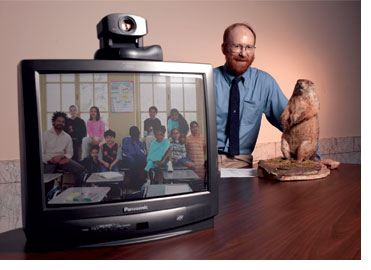Back

In
Pittsburgh’s Oakland neighborhood, which long served
as Fred Rogers’ creative base, another far-reaching
educational effort involving cameras and television screens
is well underway. Because the Pittsburgh region stands
to benefit whenever a homegrown product aims for a national
market, this small but expanding enterprise merits some
notice.
On more than 70 occasions during the past year,
staff at Carnegie Museum of Natural History have conducted
videoconferences
with elementary, middle school, and high school audiences
from New York to Texas. We market these class-length programs
to schools via electronic bulletin boards, and topics for
our classes range from moth anatomy
to dinosaurs.
As a member of the small team responsible
for the development and delivery of these new programs,
I quickly learned that,
except for the half-second delay in voice transmission,
the experience of facing a camera mounted just above the
televised image of students who are watching your televised
image on their TV monitors is pretty comparable to being
a guest instructor in a classroom. In both situations,
teaching strategies must be carefully planned
in advance and, depending on student interest, knowledge,
and behavior, they sometimes have to be drastically altered
at a moment’s notice.
A few times during these sessions,
when audio and visual connections were established several
minutes before the
formal distance learning sessions began, we had the advantage
of hearing candid student exchanges that we thought gave
us clues about our audience’s attitudes and capacity
to learn. “Did you come up with some questions like
we were supposed to?” one sixth-grader asked her
companion one late January morning as the girls entered
their classroom and unknowingly passed close by the camera
linking their Oyster Bay, Long Island classroom to equipment
some 330 miles to the west. “No,” I heard the
second student reply as I readied materials in the museum’s
first floor studio, “I thought I’d just make
something up during class.”
Forty minutes later,
during the conclusion of a session about the real creature
behind Groundhog Day folklore,
the young procrastinator posed a question that left me
admiring her intellect while stammering for some I’m-going-to-have-to-get-back-to-your-teacher-about-that
cover. “You showed us a lot of stuff about groundhog
adaptations,” she began, directing her question to
me via the camera, “but how did hibernation evolve
as a mammal behavior?”
On another occasion, when the
audio and video link wasn’t
established until exactly the time the videoconference
session was scheduled to begin, the image that flickered
onto the museum’s monitor was disarming enough to
break all my concentration. Normally, we devote the first
minute of every session to explaining how patience is required
in order to deal with the half-second sound delay in video
transmission. But on this late October afternoon, when
a second grade class from an Ann Arbor, Michigan school
suddenly appeared on the monitor wearing the hand-colored
bat masks they’d assembled in a preparatory lesson,
all I could think to say was, “Wow. You all look
so cute!”
Like many other innovative ventures in the
nonprofit sector of western Pennsylvania, the museum’s
distance learning program owes its start to a local funding
institution.
A generous grant from The Grable Foundation has covered
the cost of equipment, staff time, and the use of specialized
phone lines capable of achieving the two-way digital transmission
of image and sound.
But in spirit, at least, I can’t
help but feel that such remotely televised educational
programming also owes
a debt to another Pittsburgh institution—Fred
Rogers.
During the clean up after one videoconference with
a third-grade class in Plano, Texas, a colleague who handles
the program’s
technical side shared an observation: “I don’t
know whether you were aware of it, but when you made the
unpacking of the bat skulls part of the program, you kind
of had a ‘Mister Rogers thing’ going on.”
I
confessed to awareness, even premeditation. As proof, I
retrieved a personal reminder of the great man’s
work from a nearby table. Under the lid of a small decorative
cardboard box, the preserved remains of a chipping sparrow
rested upon a folded handkerchief. Many years ago, a representative
of Family Communications, the production
company of Mister Rogers’ Neighborhood, borrowed
the sparrow remains from the museum’s loan program
to play the part of a dead bird in an episode whose story
line explained death as a natural part of life.
 I keep that
sparrow nearby anytime my duty as a museum educator requires
me to face a camera to reach a student
audience. The lifeless specimen serves as a physical
link to the pioneer who long ago proved that the quality
products
Pittsburgh sends out to the world do not necessarily
have to leave town via trucks, barges, or on the backs
of railcars. I keep that
sparrow nearby anytime my duty as a museum educator requires
me to face a camera to reach a student
audience. The lifeless specimen serves as a physical
link to the pioneer who long ago proved that the quality
products
Pittsburgh sends out to the world do not necessarily
have to leave town via trucks, barges, or on the backs
of railcars.
Above right: The preserved sparrow
that Fred Rogers borrowed and then returned wrapped in
a new
handkerchief
and decorative box
still inspires Pat McShea today.
Since
its inception in 2002, Carnegie Museum of Natural
History’s
Distance Learning Program, made possible through a grant
from The
Grable Foundation,
has reached
more than 2,000 students and teachers as far
away as Arlington, Texas. A recent grant from the
Claude Worthington
Benedum
Foundation will support future videoconferences
in Pennsylvania and West Virginia.
Back
| Top |